The Impact of PTSD on Australian-Vietnam Veterans' Lives
VerifiedAdded on 2023/04/25
|10
|2928
|142
Report
AI Summary
This report delves into the prevalence and impact of Post-Traumatic Stress Disorder (PTSD) among Australian-Vietnam veterans. It explores the experiences of these veterans, highlighting the psychological effects of their wartime experiences, including intrusive memories, flashbacks, and sleep disturbances. The report examines the diagnostic criteria for PTSD, the various symptoms exhibited by affected individuals, and the challenges they face in daily life. It also discusses the application of prolonged exposure therapy as a key treatment approach, analyzing its mechanisms and potential barriers to implementation. A case study of a veteran, John, illustrates the assessment process and the application of therapeutic interventions. The report emphasizes the need for comprehensive assessment and tailored treatment plans to address the complex needs of veterans struggling with PTSD and contribute to their recovery and well-being. The report uses various databases like Cumulative Index of Nursing, NCBI, MDA online, PubMed and Allied Health, Cochrane databases, British Journal of Nursing and Medline for research.
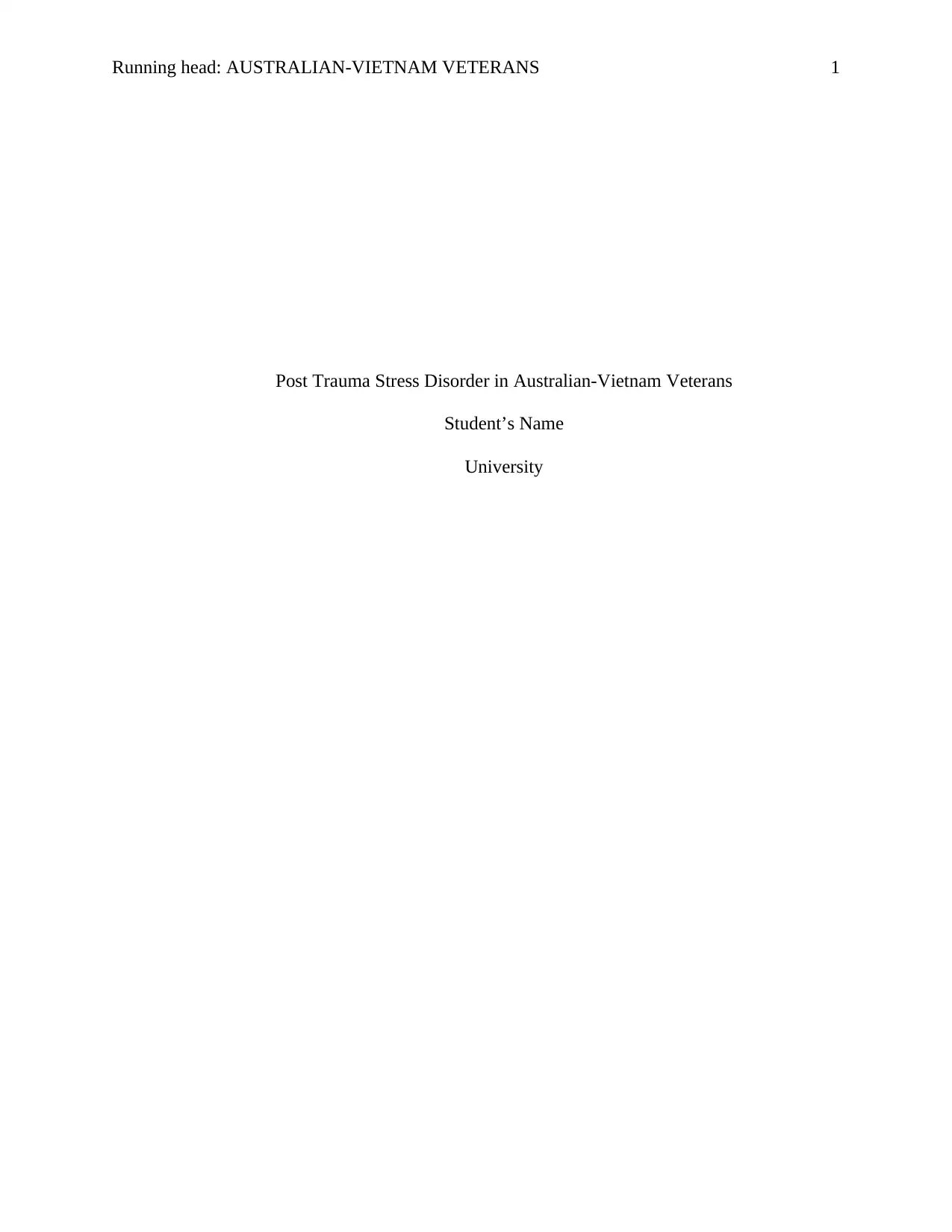
Running head: AUSTRALIAN-VIETNAM VETERANS 1
Post Trauma Stress Disorder in Australian-Vietnam Veterans
Student’s Name
University
Post Trauma Stress Disorder in Australian-Vietnam Veterans
Student’s Name
University
Paraphrase This Document
Need a fresh take? Get an instant paraphrase of this document with our AI Paraphraser
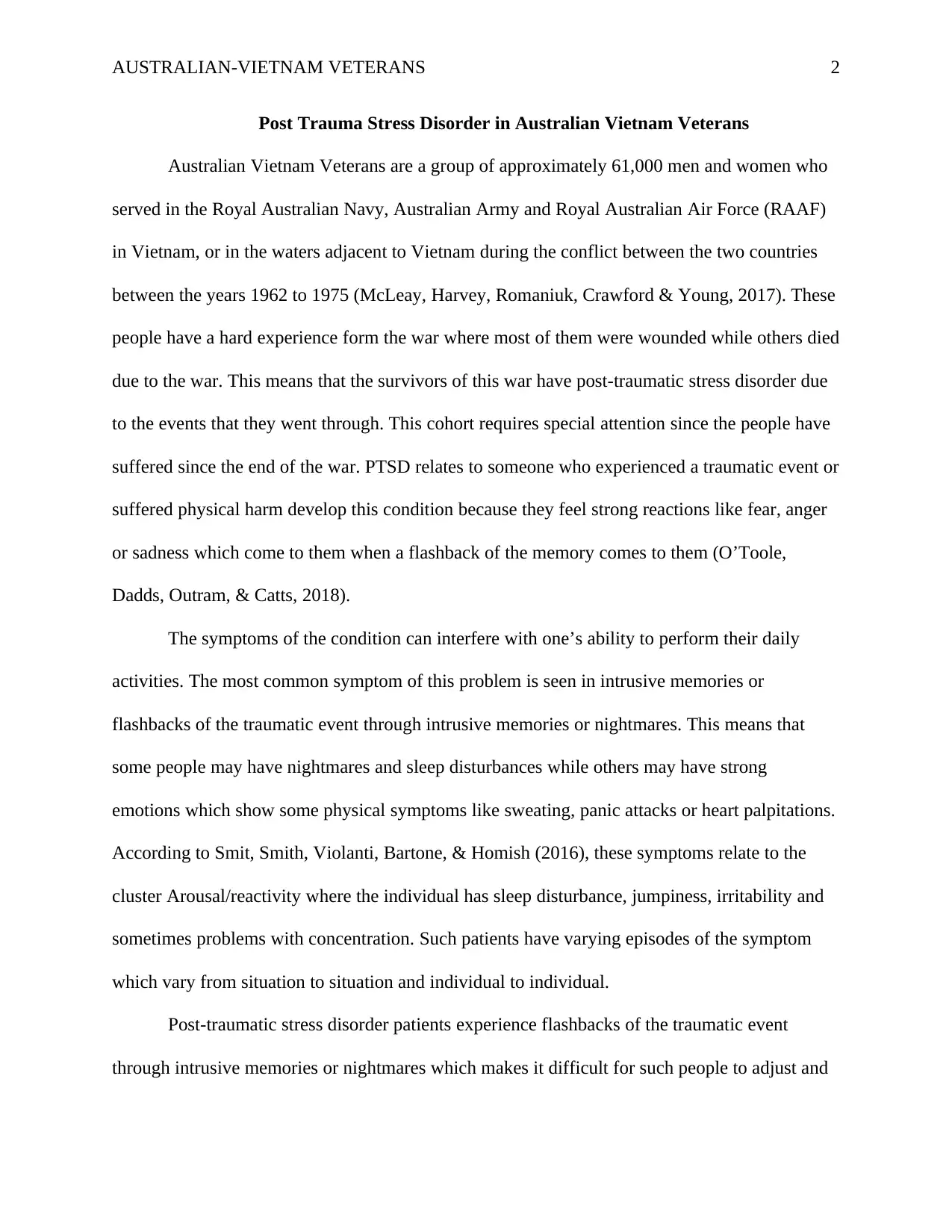
AUSTRALIAN-VIETNAM VETERANS 2
Post Trauma Stress Disorder in Australian Vietnam Veterans
Australian Vietnam Veterans are a group of approximately 61,000 men and women who
served in the Royal Australian Navy, Australian Army and Royal Australian Air Force (RAAF)
in Vietnam, or in the waters adjacent to Vietnam during the conflict between the two countries
between the years 1962 to 1975 (McLeay, Harvey, Romaniuk, Crawford & Young, 2017). These
people have a hard experience form the war where most of them were wounded while others died
due to the war. This means that the survivors of this war have post-traumatic stress disorder due
to the events that they went through. This cohort requires special attention since the people have
suffered since the end of the war. PTSD relates to someone who experienced a traumatic event or
suffered physical harm develop this condition because they feel strong reactions like fear, anger
or sadness which come to them when a flashback of the memory comes to them (O’Toole,
Dadds, Outram, & Catts, 2018).
The symptoms of the condition can interfere with one’s ability to perform their daily
activities. The most common symptom of this problem is seen in intrusive memories or
flashbacks of the traumatic event through intrusive memories or nightmares. This means that
some people may have nightmares and sleep disturbances while others may have strong
emotions which show some physical symptoms like sweating, panic attacks or heart palpitations.
According to Smit, Smith, Violanti, Bartone, & Homish (2016), these symptoms relate to the
cluster Arousal/reactivity where the individual has sleep disturbance, jumpiness, irritability and
sometimes problems with concentration. Such patients have varying episodes of the symptom
which vary from situation to situation and individual to individual.
Post-traumatic stress disorder patients experience flashbacks of the traumatic event
through intrusive memories or nightmares which makes it difficult for such people to adjust and
Post Trauma Stress Disorder in Australian Vietnam Veterans
Australian Vietnam Veterans are a group of approximately 61,000 men and women who
served in the Royal Australian Navy, Australian Army and Royal Australian Air Force (RAAF)
in Vietnam, or in the waters adjacent to Vietnam during the conflict between the two countries
between the years 1962 to 1975 (McLeay, Harvey, Romaniuk, Crawford & Young, 2017). These
people have a hard experience form the war where most of them were wounded while others died
due to the war. This means that the survivors of this war have post-traumatic stress disorder due
to the events that they went through. This cohort requires special attention since the people have
suffered since the end of the war. PTSD relates to someone who experienced a traumatic event or
suffered physical harm develop this condition because they feel strong reactions like fear, anger
or sadness which come to them when a flashback of the memory comes to them (O’Toole,
Dadds, Outram, & Catts, 2018).
The symptoms of the condition can interfere with one’s ability to perform their daily
activities. The most common symptom of this problem is seen in intrusive memories or
flashbacks of the traumatic event through intrusive memories or nightmares. This means that
some people may have nightmares and sleep disturbances while others may have strong
emotions which show some physical symptoms like sweating, panic attacks or heart palpitations.
According to Smit, Smith, Violanti, Bartone, & Homish (2016), these symptoms relate to the
cluster Arousal/reactivity where the individual has sleep disturbance, jumpiness, irritability and
sometimes problems with concentration. Such patients have varying episodes of the symptom
which vary from situation to situation and individual to individual.
Post-traumatic stress disorder patients experience flashbacks of the traumatic event
through intrusive memories or nightmares which makes it difficult for such people to adjust and
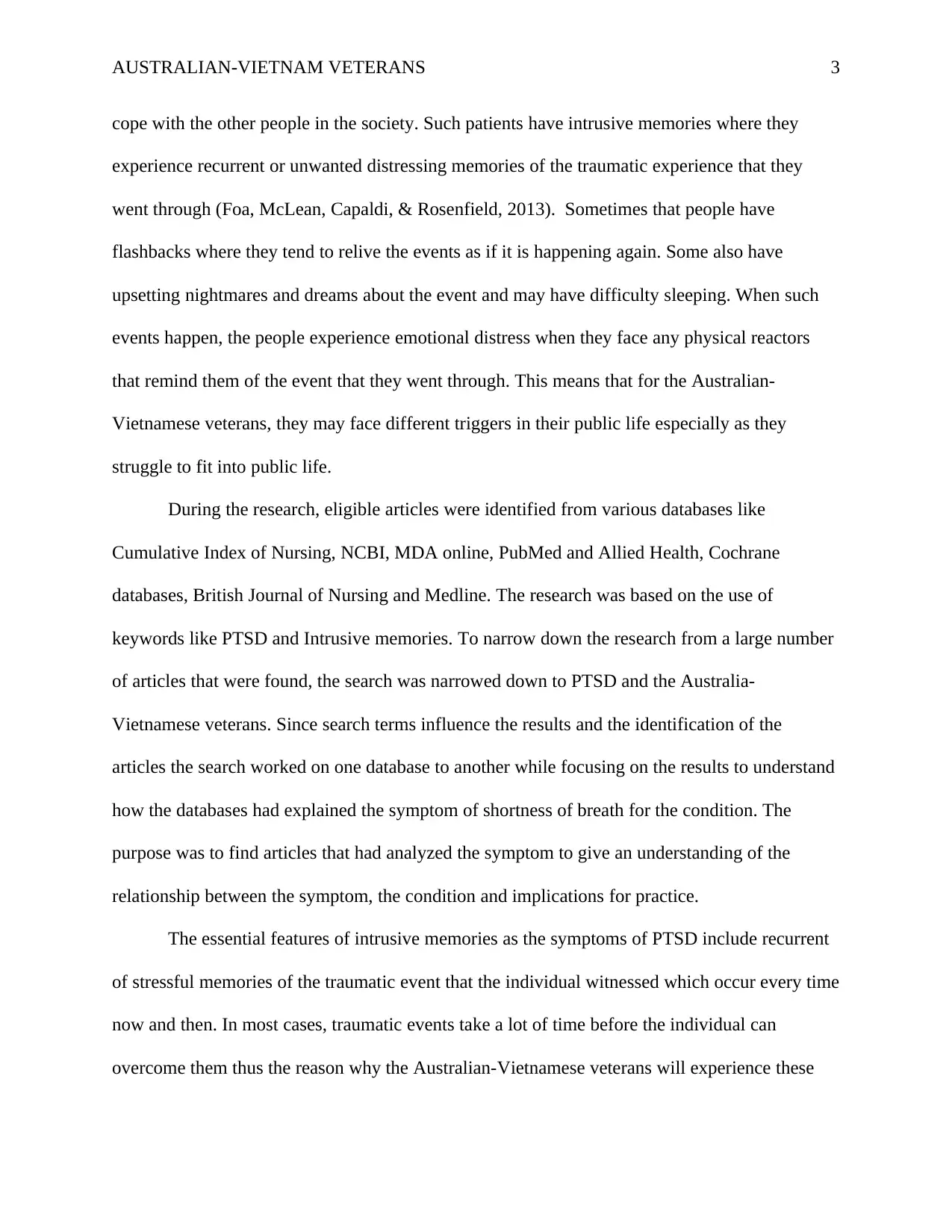
AUSTRALIAN-VIETNAM VETERANS 3
cope with the other people in the society. Such patients have intrusive memories where they
experience recurrent or unwanted distressing memories of the traumatic experience that they
went through (Foa, McLean, Capaldi, & Rosenfield, 2013). Sometimes that people have
flashbacks where they tend to relive the events as if it is happening again. Some also have
upsetting nightmares and dreams about the event and may have difficulty sleeping. When such
events happen, the people experience emotional distress when they face any physical reactors
that remind them of the event that they went through. This means that for the Australian-
Vietnamese veterans, they may face different triggers in their public life especially as they
struggle to fit into public life.
During the research, eligible articles were identified from various databases like
Cumulative Index of Nursing, NCBI, MDA online, PubMed and Allied Health, Cochrane
databases, British Journal of Nursing and Medline. The research was based on the use of
keywords like PTSD and Intrusive memories. To narrow down the research from a large number
of articles that were found, the search was narrowed down to PTSD and the Australia-
Vietnamese veterans. Since search terms influence the results and the identification of the
articles the search worked on one database to another while focusing on the results to understand
how the databases had explained the symptom of shortness of breath for the condition. The
purpose was to find articles that had analyzed the symptom to give an understanding of the
relationship between the symptom, the condition and implications for practice.
The essential features of intrusive memories as the symptoms of PTSD include recurrent
of stressful memories of the traumatic event that the individual witnessed which occur every time
now and then. In most cases, traumatic events take a lot of time before the individual can
overcome them thus the reason why the Australian-Vietnamese veterans will experience these
cope with the other people in the society. Such patients have intrusive memories where they
experience recurrent or unwanted distressing memories of the traumatic experience that they
went through (Foa, McLean, Capaldi, & Rosenfield, 2013). Sometimes that people have
flashbacks where they tend to relive the events as if it is happening again. Some also have
upsetting nightmares and dreams about the event and may have difficulty sleeping. When such
events happen, the people experience emotional distress when they face any physical reactors
that remind them of the event that they went through. This means that for the Australian-
Vietnamese veterans, they may face different triggers in their public life especially as they
struggle to fit into public life.
During the research, eligible articles were identified from various databases like
Cumulative Index of Nursing, NCBI, MDA online, PubMed and Allied Health, Cochrane
databases, British Journal of Nursing and Medline. The research was based on the use of
keywords like PTSD and Intrusive memories. To narrow down the research from a large number
of articles that were found, the search was narrowed down to PTSD and the Australia-
Vietnamese veterans. Since search terms influence the results and the identification of the
articles the search worked on one database to another while focusing on the results to understand
how the databases had explained the symptom of shortness of breath for the condition. The
purpose was to find articles that had analyzed the symptom to give an understanding of the
relationship between the symptom, the condition and implications for practice.
The essential features of intrusive memories as the symptoms of PTSD include recurrent
of stressful memories of the traumatic event that the individual witnessed which occur every time
now and then. In most cases, traumatic events take a lot of time before the individual can
overcome them thus the reason why the Australian-Vietnamese veterans will experience these
⊘ This is a preview!⊘
Do you want full access?
Subscribe today to unlock all pages.

Trusted by 1+ million students worldwide
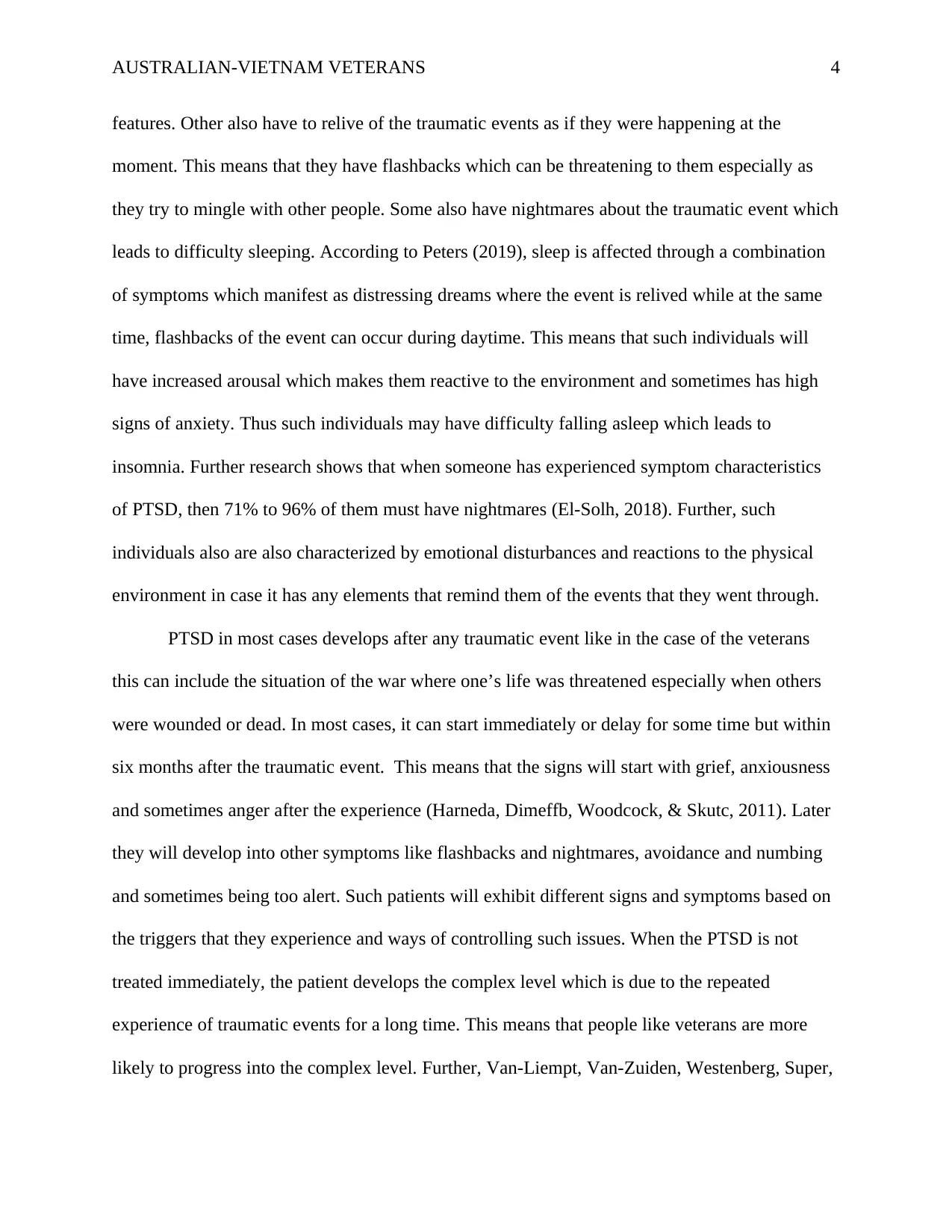
AUSTRALIAN-VIETNAM VETERANS 4
features. Other also have to relive of the traumatic events as if they were happening at the
moment. This means that they have flashbacks which can be threatening to them especially as
they try to mingle with other people. Some also have nightmares about the traumatic event which
leads to difficulty sleeping. According to Peters (2019), sleep is affected through a combination
of symptoms which manifest as distressing dreams where the event is relived while at the same
time, flashbacks of the event can occur during daytime. This means that such individuals will
have increased arousal which makes them reactive to the environment and sometimes has high
signs of anxiety. Thus such individuals may have difficulty falling asleep which leads to
insomnia. Further research shows that when someone has experienced symptom characteristics
of PTSD, then 71% to 96% of them must have nightmares (El-Solh, 2018). Further, such
individuals also are also characterized by emotional disturbances and reactions to the physical
environment in case it has any elements that remind them of the events that they went through.
PTSD in most cases develops after any traumatic event like in the case of the veterans
this can include the situation of the war where one’s life was threatened especially when others
were wounded or dead. In most cases, it can start immediately or delay for some time but within
six months after the traumatic event. This means that the signs will start with grief, anxiousness
and sometimes anger after the experience (Harneda, Dimeffb, Woodcock, & Skutc, 2011). Later
they will develop into other symptoms like flashbacks and nightmares, avoidance and numbing
and sometimes being too alert. Such patients will exhibit different signs and symptoms based on
the triggers that they experience and ways of controlling such issues. When the PTSD is not
treated immediately, the patient develops the complex level which is due to the repeated
experience of traumatic events for a long time. This means that people like veterans are more
likely to progress into the complex level. Further, Van-Liempt, Van-Zuiden, Westenberg, Super,
features. Other also have to relive of the traumatic events as if they were happening at the
moment. This means that they have flashbacks which can be threatening to them especially as
they try to mingle with other people. Some also have nightmares about the traumatic event which
leads to difficulty sleeping. According to Peters (2019), sleep is affected through a combination
of symptoms which manifest as distressing dreams where the event is relived while at the same
time, flashbacks of the event can occur during daytime. This means that such individuals will
have increased arousal which makes them reactive to the environment and sometimes has high
signs of anxiety. Thus such individuals may have difficulty falling asleep which leads to
insomnia. Further research shows that when someone has experienced symptom characteristics
of PTSD, then 71% to 96% of them must have nightmares (El-Solh, 2018). Further, such
individuals also are also characterized by emotional disturbances and reactions to the physical
environment in case it has any elements that remind them of the events that they went through.
PTSD in most cases develops after any traumatic event like in the case of the veterans
this can include the situation of the war where one’s life was threatened especially when others
were wounded or dead. In most cases, it can start immediately or delay for some time but within
six months after the traumatic event. This means that the signs will start with grief, anxiousness
and sometimes anger after the experience (Harneda, Dimeffb, Woodcock, & Skutc, 2011). Later
they will develop into other symptoms like flashbacks and nightmares, avoidance and numbing
and sometimes being too alert. Such patients will exhibit different signs and symptoms based on
the triggers that they experience and ways of controlling such issues. When the PTSD is not
treated immediately, the patient develops the complex level which is due to the repeated
experience of traumatic events for a long time. This means that people like veterans are more
likely to progress into the complex level. Further, Van-Liempt, Van-Zuiden, Westenberg, Super,
Paraphrase This Document
Need a fresh take? Get an instant paraphrase of this document with our AI Paraphraser
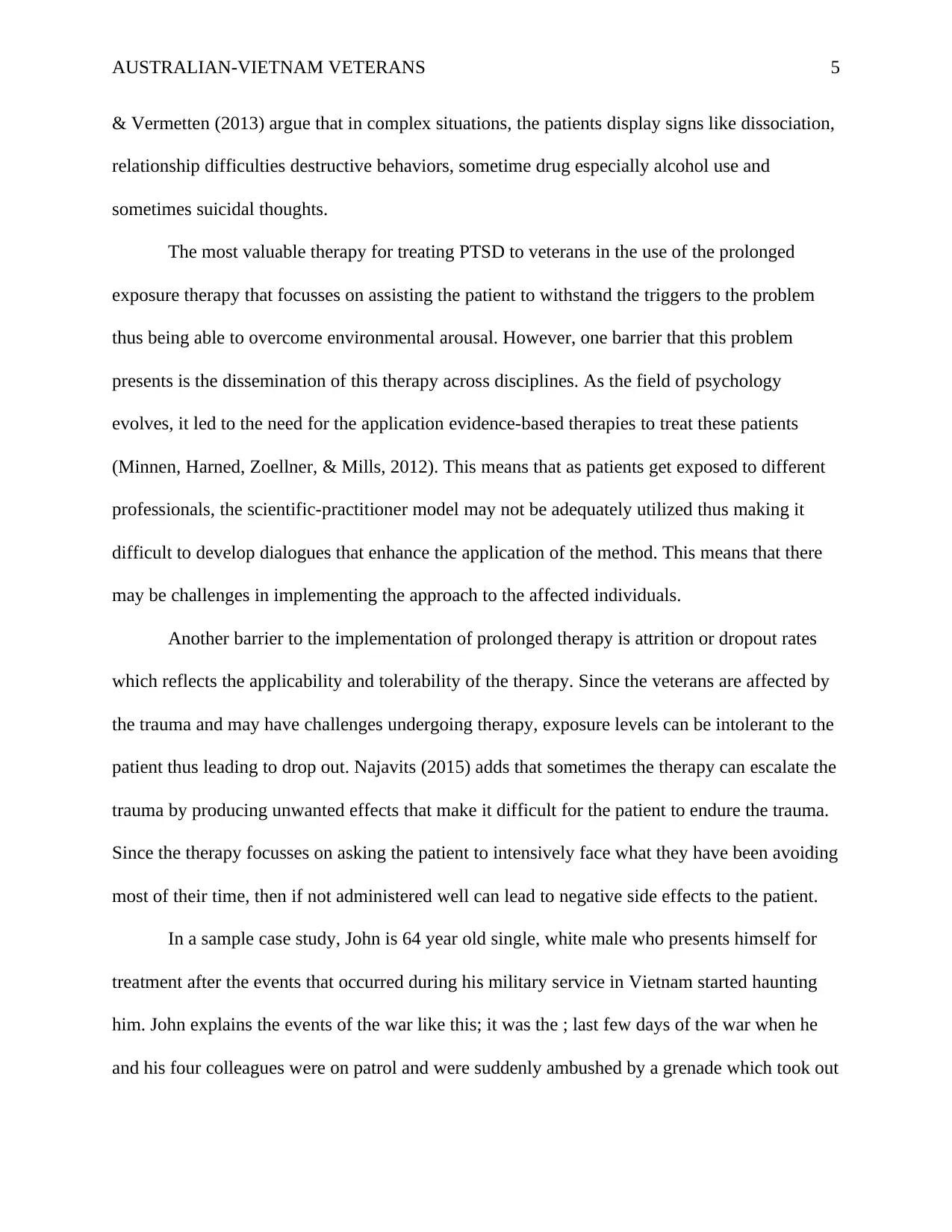
AUSTRALIAN-VIETNAM VETERANS 5
& Vermetten (2013) argue that in complex situations, the patients display signs like dissociation,
relationship difficulties destructive behaviors, sometime drug especially alcohol use and
sometimes suicidal thoughts.
The most valuable therapy for treating PTSD to veterans in the use of the prolonged
exposure therapy that focusses on assisting the patient to withstand the triggers to the problem
thus being able to overcome environmental arousal. However, one barrier that this problem
presents is the dissemination of this therapy across disciplines. As the field of psychology
evolves, it led to the need for the application evidence-based therapies to treat these patients
(Minnen, Harned, Zoellner, & Mills, 2012). This means that as patients get exposed to different
professionals, the scientific-practitioner model may not be adequately utilized thus making it
difficult to develop dialogues that enhance the application of the method. This means that there
may be challenges in implementing the approach to the affected individuals.
Another barrier to the implementation of prolonged therapy is attrition or dropout rates
which reflects the applicability and tolerability of the therapy. Since the veterans are affected by
the trauma and may have challenges undergoing therapy, exposure levels can be intolerant to the
patient thus leading to drop out. Najavits (2015) adds that sometimes the therapy can escalate the
trauma by producing unwanted effects that make it difficult for the patient to endure the trauma.
Since the therapy focusses on asking the patient to intensively face what they have been avoiding
most of their time, then if not administered well can lead to negative side effects to the patient.
In a sample case study, John is 64 year old single, white male who presents himself for
treatment after the events that occurred during his military service in Vietnam started haunting
him. John explains the events of the war like this; it was the ; last few days of the war when he
and his four colleagues were on patrol and were suddenly ambushed by a grenade which took out
& Vermetten (2013) argue that in complex situations, the patients display signs like dissociation,
relationship difficulties destructive behaviors, sometime drug especially alcohol use and
sometimes suicidal thoughts.
The most valuable therapy for treating PTSD to veterans in the use of the prolonged
exposure therapy that focusses on assisting the patient to withstand the triggers to the problem
thus being able to overcome environmental arousal. However, one barrier that this problem
presents is the dissemination of this therapy across disciplines. As the field of psychology
evolves, it led to the need for the application evidence-based therapies to treat these patients
(Minnen, Harned, Zoellner, & Mills, 2012). This means that as patients get exposed to different
professionals, the scientific-practitioner model may not be adequately utilized thus making it
difficult to develop dialogues that enhance the application of the method. This means that there
may be challenges in implementing the approach to the affected individuals.
Another barrier to the implementation of prolonged therapy is attrition or dropout rates
which reflects the applicability and tolerability of the therapy. Since the veterans are affected by
the trauma and may have challenges undergoing therapy, exposure levels can be intolerant to the
patient thus leading to drop out. Najavits (2015) adds that sometimes the therapy can escalate the
trauma by producing unwanted effects that make it difficult for the patient to endure the trauma.
Since the therapy focusses on asking the patient to intensively face what they have been avoiding
most of their time, then if not administered well can lead to negative side effects to the patient.
In a sample case study, John is 64 year old single, white male who presents himself for
treatment after the events that occurred during his military service in Vietnam started haunting
him. John explains the events of the war like this; it was the ; last few days of the war when he
and his four colleagues were on patrol and were suddenly ambushed by a grenade which took out
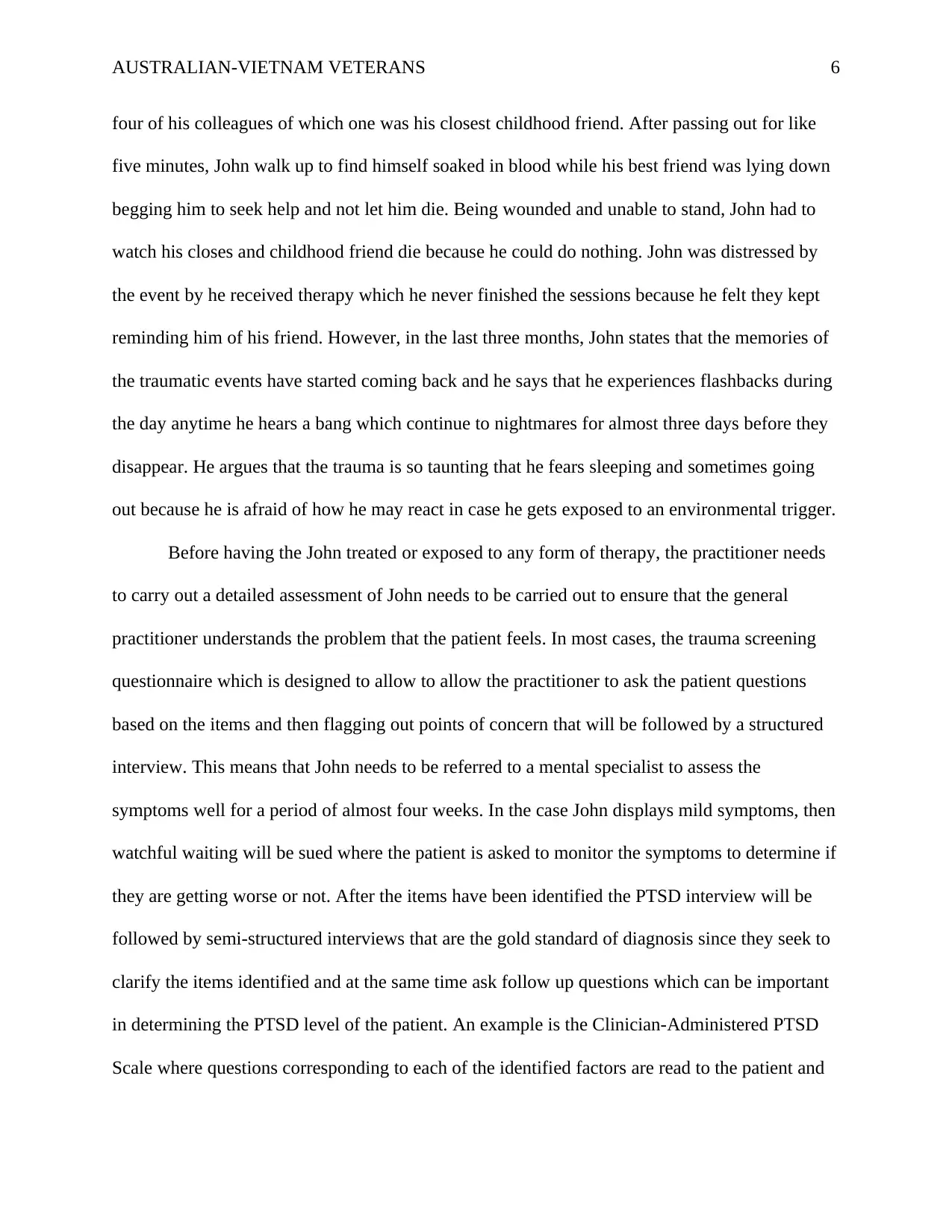
AUSTRALIAN-VIETNAM VETERANS 6
four of his colleagues of which one was his closest childhood friend. After passing out for like
five minutes, John walk up to find himself soaked in blood while his best friend was lying down
begging him to seek help and not let him die. Being wounded and unable to stand, John had to
watch his closes and childhood friend die because he could do nothing. John was distressed by
the event by he received therapy which he never finished the sessions because he felt they kept
reminding him of his friend. However, in the last three months, John states that the memories of
the traumatic events have started coming back and he says that he experiences flashbacks during
the day anytime he hears a bang which continue to nightmares for almost three days before they
disappear. He argues that the trauma is so taunting that he fears sleeping and sometimes going
out because he is afraid of how he may react in case he gets exposed to an environmental trigger.
Before having the John treated or exposed to any form of therapy, the practitioner needs
to carry out a detailed assessment of John needs to be carried out to ensure that the general
practitioner understands the problem that the patient feels. In most cases, the trauma screening
questionnaire which is designed to allow to allow the practitioner to ask the patient questions
based on the items and then flagging out points of concern that will be followed by a structured
interview. This means that John needs to be referred to a mental specialist to assess the
symptoms well for a period of almost four weeks. In the case John displays mild symptoms, then
watchful waiting will be sued where the patient is asked to monitor the symptoms to determine if
they are getting worse or not. After the items have been identified the PTSD interview will be
followed by semi-structured interviews that are the gold standard of diagnosis since they seek to
clarify the items identified and at the same time ask follow up questions which can be important
in determining the PTSD level of the patient. An example is the Clinician-Administered PTSD
Scale where questions corresponding to each of the identified factors are read to the patient and
four of his colleagues of which one was his closest childhood friend. After passing out for like
five minutes, John walk up to find himself soaked in blood while his best friend was lying down
begging him to seek help and not let him die. Being wounded and unable to stand, John had to
watch his closes and childhood friend die because he could do nothing. John was distressed by
the event by he received therapy which he never finished the sessions because he felt they kept
reminding him of his friend. However, in the last three months, John states that the memories of
the traumatic events have started coming back and he says that he experiences flashbacks during
the day anytime he hears a bang which continue to nightmares for almost three days before they
disappear. He argues that the trauma is so taunting that he fears sleeping and sometimes going
out because he is afraid of how he may react in case he gets exposed to an environmental trigger.
Before having the John treated or exposed to any form of therapy, the practitioner needs
to carry out a detailed assessment of John needs to be carried out to ensure that the general
practitioner understands the problem that the patient feels. In most cases, the trauma screening
questionnaire which is designed to allow to allow the practitioner to ask the patient questions
based on the items and then flagging out points of concern that will be followed by a structured
interview. This means that John needs to be referred to a mental specialist to assess the
symptoms well for a period of almost four weeks. In the case John displays mild symptoms, then
watchful waiting will be sued where the patient is asked to monitor the symptoms to determine if
they are getting worse or not. After the items have been identified the PTSD interview will be
followed by semi-structured interviews that are the gold standard of diagnosis since they seek to
clarify the items identified and at the same time ask follow up questions which can be important
in determining the PTSD level of the patient. An example is the Clinician-Administered PTSD
Scale where questions corresponding to each of the identified factors are read to the patient and
⊘ This is a preview!⊘
Do you want full access?
Subscribe today to unlock all pages.

Trusted by 1+ million students worldwide
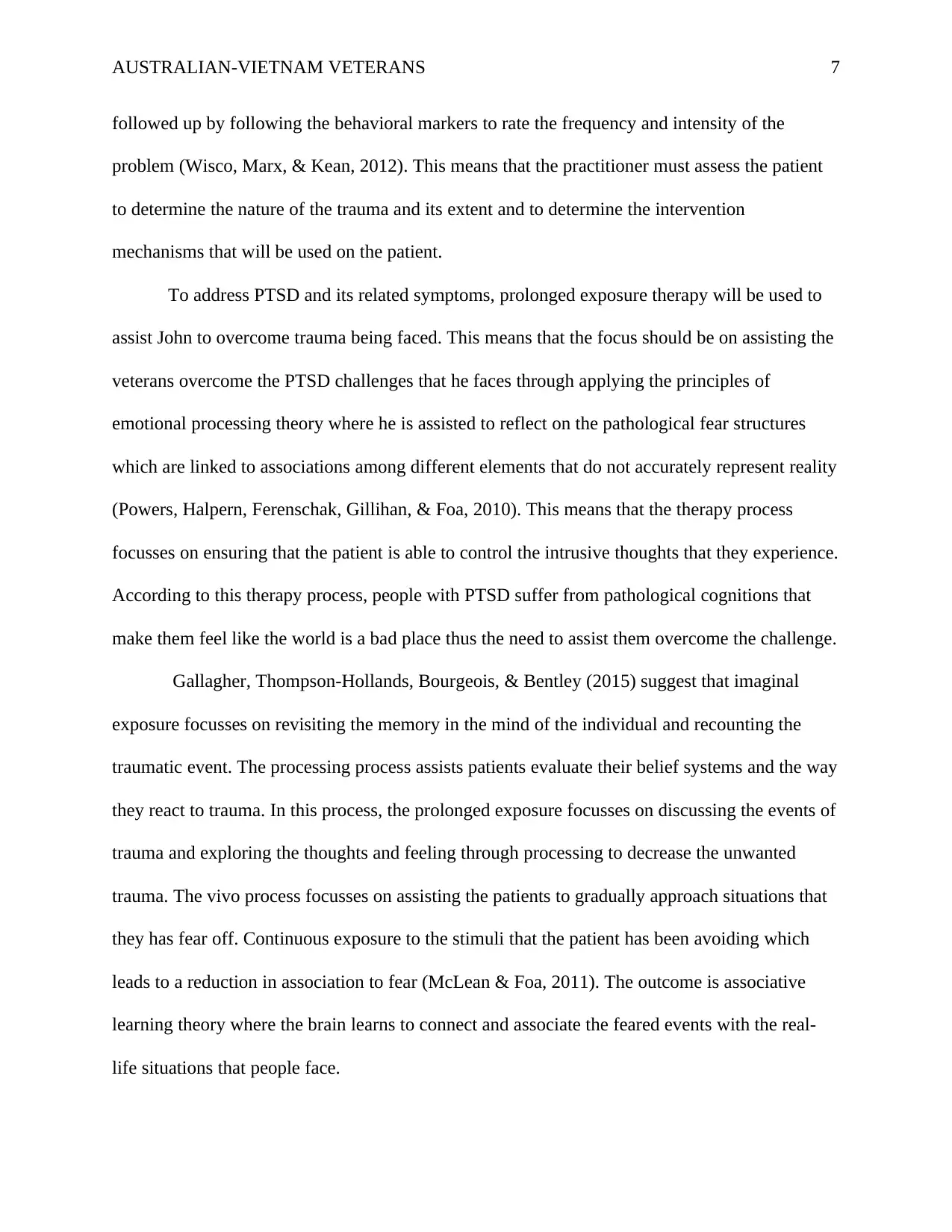
AUSTRALIAN-VIETNAM VETERANS 7
followed up by following the behavioral markers to rate the frequency and intensity of the
problem (Wisco, Marx, & Kean, 2012). This means that the practitioner must assess the patient
to determine the nature of the trauma and its extent and to determine the intervention
mechanisms that will be used on the patient.
To address PTSD and its related symptoms, prolonged exposure therapy will be used to
assist John to overcome trauma being faced. This means that the focus should be on assisting the
veterans overcome the PTSD challenges that he faces through applying the principles of
emotional processing theory where he is assisted to reflect on the pathological fear structures
which are linked to associations among different elements that do not accurately represent reality
(Powers, Halpern, Ferenschak, Gillihan, & Foa, 2010). This means that the therapy process
focusses on ensuring that the patient is able to control the intrusive thoughts that they experience.
According to this therapy process, people with PTSD suffer from pathological cognitions that
make them feel like the world is a bad place thus the need to assist them overcome the challenge.
Gallagher, Thompson-Hollands, Bourgeois, & Bentley (2015) suggest that imaginal
exposure focusses on revisiting the memory in the mind of the individual and recounting the
traumatic event. The processing process assists patients evaluate their belief systems and the way
they react to trauma. In this process, the prolonged exposure focusses on discussing the events of
trauma and exploring the thoughts and feeling through processing to decrease the unwanted
trauma. The vivo process focusses on assisting the patients to gradually approach situations that
they has fear off. Continuous exposure to the stimuli that the patient has been avoiding which
leads to a reduction in association to fear (McLean & Foa, 2011). The outcome is associative
learning theory where the brain learns to connect and associate the feared events with the real-
life situations that people face.
followed up by following the behavioral markers to rate the frequency and intensity of the
problem (Wisco, Marx, & Kean, 2012). This means that the practitioner must assess the patient
to determine the nature of the trauma and its extent and to determine the intervention
mechanisms that will be used on the patient.
To address PTSD and its related symptoms, prolonged exposure therapy will be used to
assist John to overcome trauma being faced. This means that the focus should be on assisting the
veterans overcome the PTSD challenges that he faces through applying the principles of
emotional processing theory where he is assisted to reflect on the pathological fear structures
which are linked to associations among different elements that do not accurately represent reality
(Powers, Halpern, Ferenschak, Gillihan, & Foa, 2010). This means that the therapy process
focusses on ensuring that the patient is able to control the intrusive thoughts that they experience.
According to this therapy process, people with PTSD suffer from pathological cognitions that
make them feel like the world is a bad place thus the need to assist them overcome the challenge.
Gallagher, Thompson-Hollands, Bourgeois, & Bentley (2015) suggest that imaginal
exposure focusses on revisiting the memory in the mind of the individual and recounting the
traumatic event. The processing process assists patients evaluate their belief systems and the way
they react to trauma. In this process, the prolonged exposure focusses on discussing the events of
trauma and exploring the thoughts and feeling through processing to decrease the unwanted
trauma. The vivo process focusses on assisting the patients to gradually approach situations that
they has fear off. Continuous exposure to the stimuli that the patient has been avoiding which
leads to a reduction in association to fear (McLean & Foa, 2011). The outcome is associative
learning theory where the brain learns to connect and associate the feared events with the real-
life situations that people face.
Paraphrase This Document
Need a fresh take? Get an instant paraphrase of this document with our AI Paraphraser
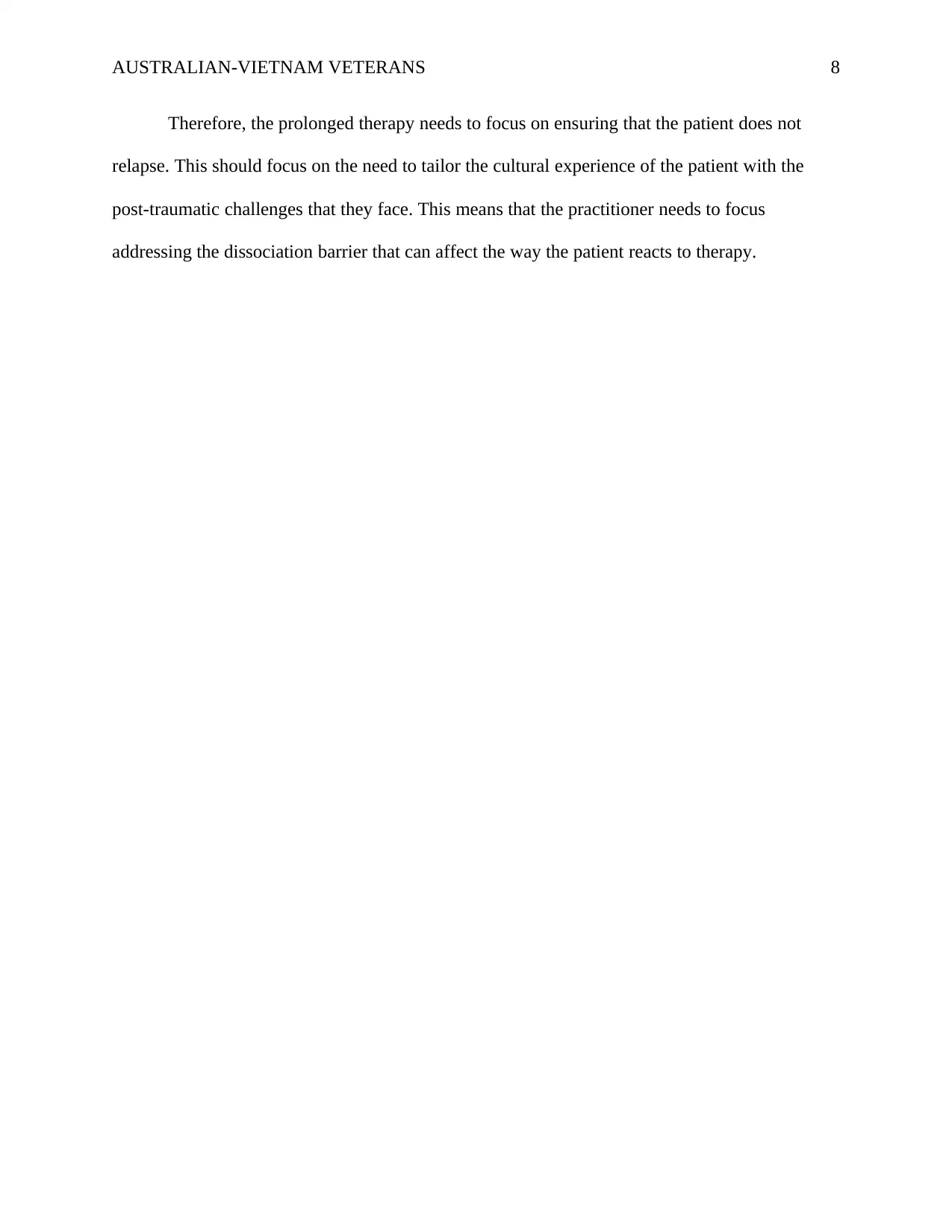
AUSTRALIAN-VIETNAM VETERANS 8
Therefore, the prolonged therapy needs to focus on ensuring that the patient does not
relapse. This should focus on the need to tailor the cultural experience of the patient with the
post-traumatic challenges that they face. This means that the practitioner needs to focus
addressing the dissociation barrier that can affect the way the patient reacts to therapy.
Therefore, the prolonged therapy needs to focus on ensuring that the patient does not
relapse. This should focus on the need to tailor the cultural experience of the patient with the
post-traumatic challenges that they face. This means that the practitioner needs to focus
addressing the dissociation barrier that can affect the way the patient reacts to therapy.
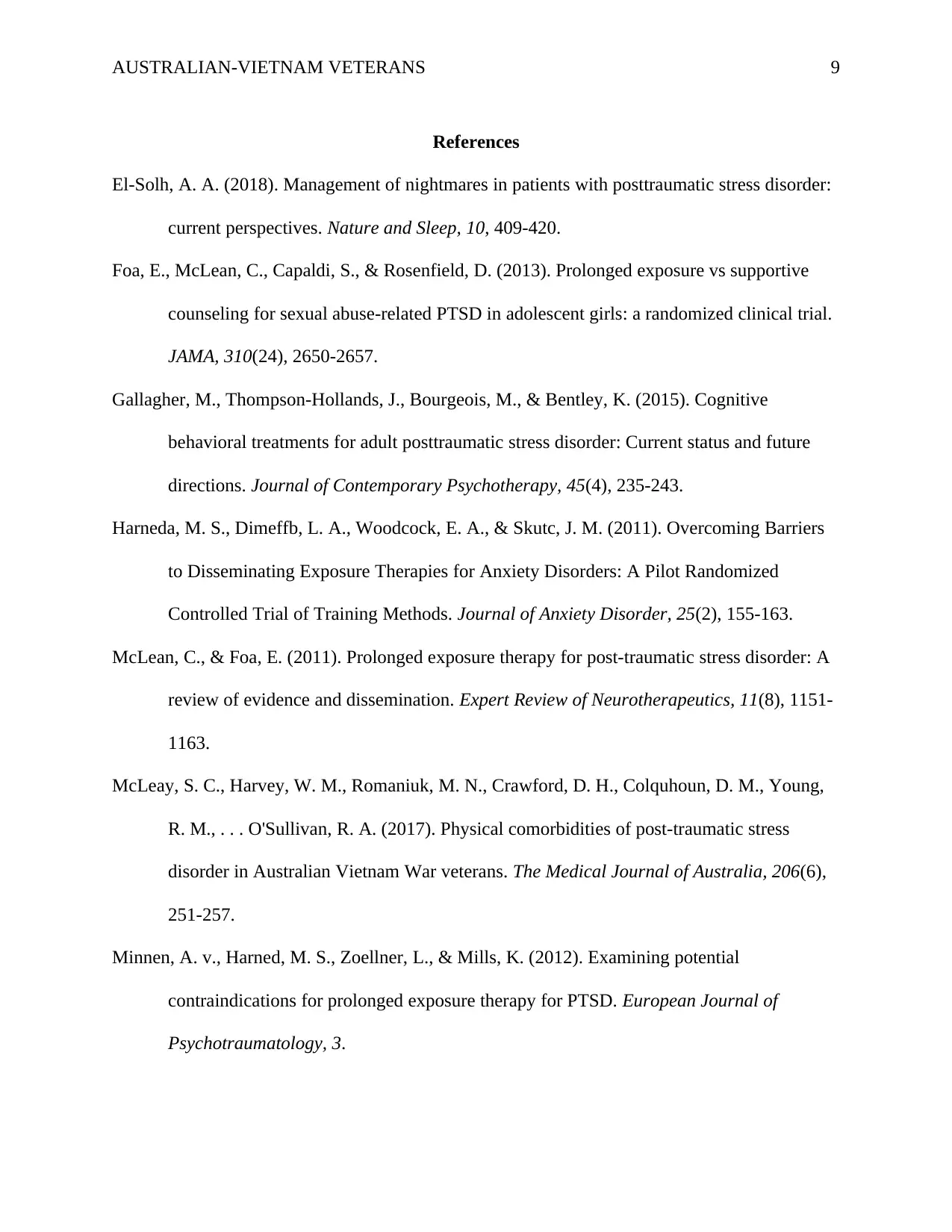
AUSTRALIAN-VIETNAM VETERANS 9
References
El-Solh, A. A. (2018). Management of nightmares in patients with posttraumatic stress disorder:
current perspectives. Nature and Sleep, 10, 409-420.
Foa, E., McLean, C., Capaldi, S., & Rosenfield, D. (2013). Prolonged exposure vs supportive
counseling for sexual abuse-related PTSD in adolescent girls: a randomized clinical trial.
JAMA, 310(24), 2650-2657.
Gallagher, M., Thompson-Hollands, J., Bourgeois, M., & Bentley, K. (2015). Cognitive
behavioral treatments for adult posttraumatic stress disorder: Current status and future
directions. Journal of Contemporary Psychotherapy, 45(4), 235-243.
Harneda, M. S., Dimeffb, L. A., Woodcock, E. A., & Skutc, J. M. (2011). Overcoming Barriers
to Disseminating Exposure Therapies for Anxiety Disorders: A Pilot Randomized
Controlled Trial of Training Methods. Journal of Anxiety Disorder, 25(2), 155-163.
McLean, C., & Foa, E. (2011). Prolonged exposure therapy for post-traumatic stress disorder: A
review of evidence and dissemination. Expert Review of Neurotherapeutics, 11(8), 1151-
1163.
McLeay, S. C., Harvey, W. M., Romaniuk, M. N., Crawford, D. H., Colquhoun, D. M., Young,
R. M., . . . O'Sullivan, R. A. (2017). Physical comorbidities of post-traumatic stress
disorder in Australian Vietnam War veterans. The Medical Journal of Australia, 206(6),
251-257.
Minnen, A. v., Harned, M. S., Zoellner, L., & Mills, K. (2012). Examining potential
contraindications for prolonged exposure therapy for PTSD. European Journal of
Psychotraumatology, 3.
References
El-Solh, A. A. (2018). Management of nightmares in patients with posttraumatic stress disorder:
current perspectives. Nature and Sleep, 10, 409-420.
Foa, E., McLean, C., Capaldi, S., & Rosenfield, D. (2013). Prolonged exposure vs supportive
counseling for sexual abuse-related PTSD in adolescent girls: a randomized clinical trial.
JAMA, 310(24), 2650-2657.
Gallagher, M., Thompson-Hollands, J., Bourgeois, M., & Bentley, K. (2015). Cognitive
behavioral treatments for adult posttraumatic stress disorder: Current status and future
directions. Journal of Contemporary Psychotherapy, 45(4), 235-243.
Harneda, M. S., Dimeffb, L. A., Woodcock, E. A., & Skutc, J. M. (2011). Overcoming Barriers
to Disseminating Exposure Therapies for Anxiety Disorders: A Pilot Randomized
Controlled Trial of Training Methods. Journal of Anxiety Disorder, 25(2), 155-163.
McLean, C., & Foa, E. (2011). Prolonged exposure therapy for post-traumatic stress disorder: A
review of evidence and dissemination. Expert Review of Neurotherapeutics, 11(8), 1151-
1163.
McLeay, S. C., Harvey, W. M., Romaniuk, M. N., Crawford, D. H., Colquhoun, D. M., Young,
R. M., . . . O'Sullivan, R. A. (2017). Physical comorbidities of post-traumatic stress
disorder in Australian Vietnam War veterans. The Medical Journal of Australia, 206(6),
251-257.
Minnen, A. v., Harned, M. S., Zoellner, L., & Mills, K. (2012). Examining potential
contraindications for prolonged exposure therapy for PTSD. European Journal of
Psychotraumatology, 3.
⊘ This is a preview!⊘
Do you want full access?
Subscribe today to unlock all pages.

Trusted by 1+ million students worldwide
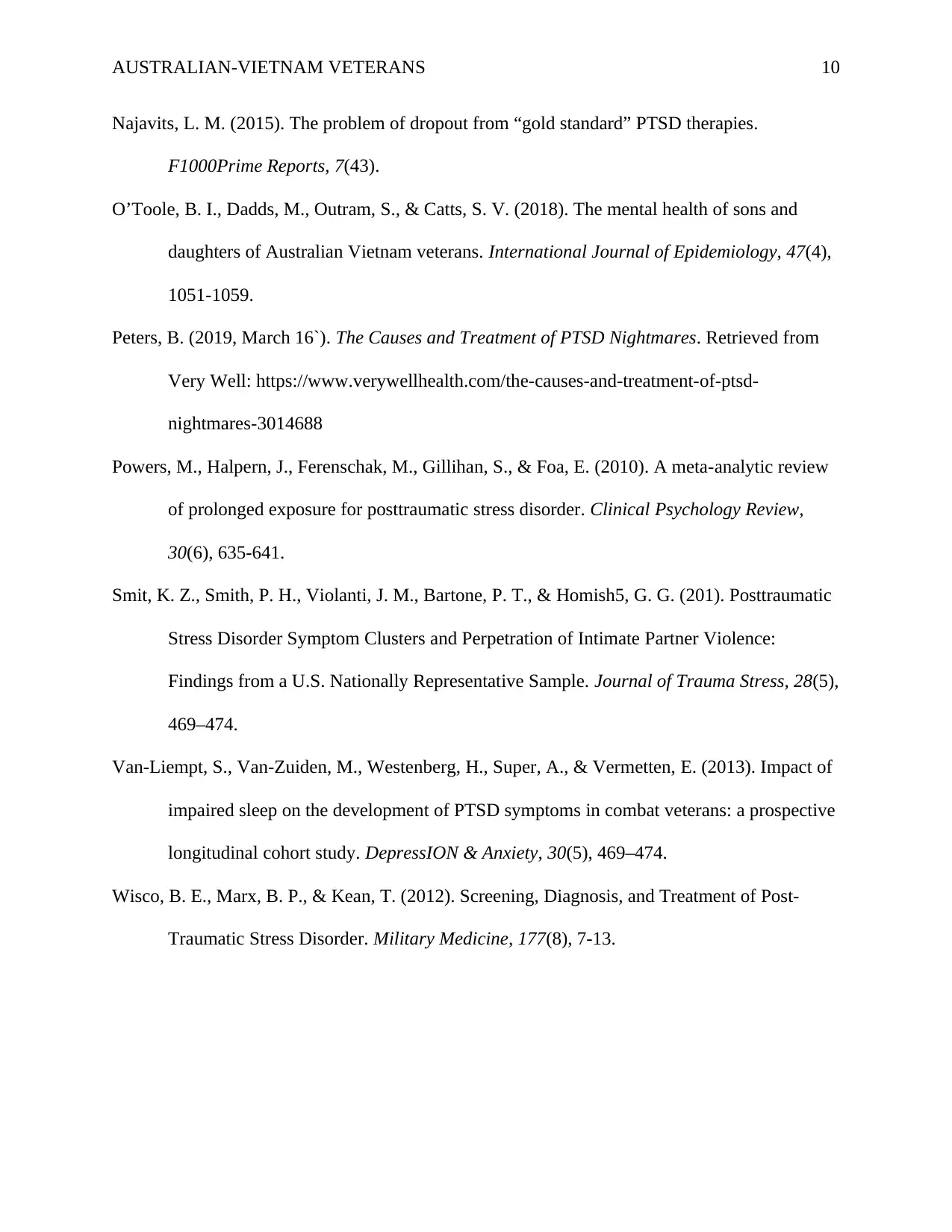
AUSTRALIAN-VIETNAM VETERANS 10
Najavits, L. M. (2015). The problem of dropout from “gold standard” PTSD therapies.
F1000Prime Reports, 7(43).
O’Toole, B. I., Dadds, M., Outram, S., & Catts, S. V. (2018). The mental health of sons and
daughters of Australian Vietnam veterans. International Journal of Epidemiology, 47(4),
1051-1059.
Peters, B. (2019, March 16`). The Causes and Treatment of PTSD Nightmares. Retrieved from
Very Well: https://www.verywellhealth.com/the-causes-and-treatment-of-ptsd-
nightmares-3014688
Powers, M., Halpern, J., Ferenschak, M., Gillihan, S., & Foa, E. (2010). A meta-analytic review
of prolonged exposure for posttraumatic stress disorder. Clinical Psychology Review,
30(6), 635-641.
Smit, K. Z., Smith, P. H., Violanti, J. M., Bartone, P. T., & Homish5, G. G. (201). Posttraumatic
Stress Disorder Symptom Clusters and Perpetration of Intimate Partner Violence:
Findings from a U.S. Nationally Representative Sample. Journal of Trauma Stress, 28(5),
469–474.
Van-Liempt, S., Van-Zuiden, M., Westenberg, H., Super, A., & Vermetten, E. (2013). Impact of
impaired sleep on the development of PTSD symptoms in combat veterans: a prospective
longitudinal cohort study. DepressION & Anxiety, 30(5), 469–474.
Wisco, B. E., Marx, B. P., & Kean, T. (2012). Screening, Diagnosis, and Treatment of Post-
Traumatic Stress Disorder. Military Medicine, 177(8), 7-13.
Najavits, L. M. (2015). The problem of dropout from “gold standard” PTSD therapies.
F1000Prime Reports, 7(43).
O’Toole, B. I., Dadds, M., Outram, S., & Catts, S. V. (2018). The mental health of sons and
daughters of Australian Vietnam veterans. International Journal of Epidemiology, 47(4),
1051-1059.
Peters, B. (2019, March 16`). The Causes and Treatment of PTSD Nightmares. Retrieved from
Very Well: https://www.verywellhealth.com/the-causes-and-treatment-of-ptsd-
nightmares-3014688
Powers, M., Halpern, J., Ferenschak, M., Gillihan, S., & Foa, E. (2010). A meta-analytic review
of prolonged exposure for posttraumatic stress disorder. Clinical Psychology Review,
30(6), 635-641.
Smit, K. Z., Smith, P. H., Violanti, J. M., Bartone, P. T., & Homish5, G. G. (201). Posttraumatic
Stress Disorder Symptom Clusters and Perpetration of Intimate Partner Violence:
Findings from a U.S. Nationally Representative Sample. Journal of Trauma Stress, 28(5),
469–474.
Van-Liempt, S., Van-Zuiden, M., Westenberg, H., Super, A., & Vermetten, E. (2013). Impact of
impaired sleep on the development of PTSD symptoms in combat veterans: a prospective
longitudinal cohort study. DepressION & Anxiety, 30(5), 469–474.
Wisco, B. E., Marx, B. P., & Kean, T. (2012). Screening, Diagnosis, and Treatment of Post-
Traumatic Stress Disorder. Military Medicine, 177(8), 7-13.
1 out of 10
Related Documents
Your All-in-One AI-Powered Toolkit for Academic Success.
+13062052269
info@desklib.com
Available 24*7 on WhatsApp / Email
![[object Object]](/_next/static/media/star-bottom.7253800d.svg)
Unlock your academic potential
Copyright © 2020–2025 A2Z Services. All Rights Reserved. Developed and managed by ZUCOL.





